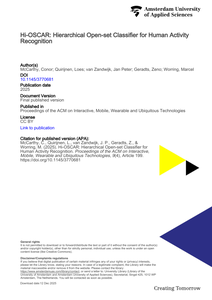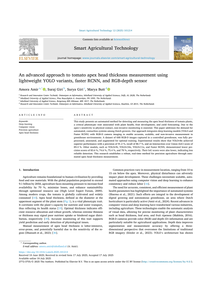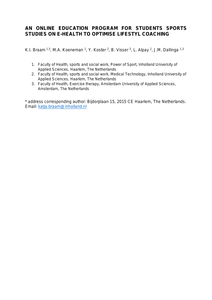This paper reports on the first stage of a research project1) that aims to incorporate objective measures of physical activity into health and lifestyle surveys. Physical activity is typically measured with questionnaires that are known to have measurement issues, and specifically, overestimate the amount of physical activity of the population. In a lab setting, 40 participants wore four different sensors on five different body parts, while performing various activities (sitting, standing, stepping with two intensities, bicycling with two intensities, walking stairs and jumping). During the first four activities, energy expenditure was measured by monitoring heart rate and the gas volume of in‐ and expired O2 and CO2. Participants subsequently wore two sensor systems (the ActivPAL on the thigh and the UKK on the waist) for a week. They also kept a diary keeping track of their physical activities, work and travel hours. Machine learning algorithms were trained with different methods to determine which sensor and which method was best able to differentiate the various activities and the intensity with which they were performed. It was found that the ActivPAL had the highest overall accuracy, possibly because the data generated on the upper tigh seems to be best distinguishing between different types of activities and therefore led to the highest accuracy. Accuracy could be slightly increased by including measures of heartrate. For recognizing intensity, three different measures were compared: allocation of MET values to activities (used by ActivPAL), median absolute deviation, and heart rate. It turns out that each method has merits and disadvantages, but median absolute deviation seems to be the most promishing metric. The search for the best method of gauging intensity is still ongoing. Subsequently, the algorithms developed for the lab data were used to determine physical activity in the week people wore the devices during their everyday activities. It quickly turned out that the models are far from ready to be used on free living data. Two approaches are suggested to remedy this: additional research with meticulously labelled free living data, e.g., by combining a Time Use Survey with accelerometer measurements. The second is to focus on better determining intensity of movement, e.g., with the help of unsupervised pattern recognition techniques. Accuracy was but one of the requirements for choosing a sensor system for subsequent research and ultimate implementation of sensor measurement in health surveys. Sensor position on the body, wearability, costs, usability, flexibility of analysis, response, and adherence to protocol equally determine the choice for a sensor. Also from these additional points of view, the activPAL is our sensor of choice.
DOCUMENT

Wat zijn belangrijke succesfactoren om onderzoek, onderwijs en ondernemen bij elkaar te brengen, zó dat 'het klikt'. De uitdaging voor de toekomst van bedrijven in de smart factoryligt bij data science: het omzetten van ruwe (sensor) data naar (zinnige) informatie en kennis, waarmee producten en diensten verbeterd kunnen worden. Tevens programma van het symposium t.g.l. inauguratie 3 december 2015
MULTIFILE

Within rehabilitation, there is a great need for a simple method to monitor wheelchair use, especially whether it is active or passive. For this purpose, an existing measurement technique was extended with a method for detecting self- or attendant-pushed wheelchair propulsion. The aim of this study was to validate this new detection method by comparison with manual annotation of wheelchair use. Twenty-four amputation and stroke patients completed a semi-structured course of active and passive wheelchair use. Based on a machine learning approach, a method was developed that detected the type of movement. The machine learning method was trained based on the data of a single-wheel sensor as well as a setup using an additional sensor on the frame. The method showed high accuracy (F1 = 0.886, frame and wheel sensor) even if only a single wheel sensor was used (F1 = 0.827). The developed and validated measurement method is ideally suited to easily determine wheelchair use and the corresponding activity level of patients in rehabilitation.
DOCUMENT

This paper introduces a novel distributed algorithm designed to optimize the deployment of access points within Mobile Ad Hoc Networks (MANETs) for better service quality in infrastructure less environments. The algorithm operates based on local, independent execution by each network node, thus ensuring a high degree of scalability and adaptability to changing network conditions. The primary focus is to match the spatial distribution of access points with the distribution of client devices while maintaining strong connectivity to the network root. Using autonomous decision-making and choreographed path-planning, this algorithm bridges the gap between demand-responsive network service provision and the maintenance of crucial network connectivity links. The assessment of the performance of this approach is motivated by using numerical results generated by simulations.
DOCUMENT

Athlete development depends on many factors that need to be balanced by the coach. The amount of data collected grows with the development of sensor technology. To make data-informed decisions for training prescription of their athletes, coaches could be supported by feedback through a coach dashboard. The aim of this paper is to describe the design of a coach dashboard based on scientific knowledge, user requirements, and (sensor) data to support decision making of coaches for athlete development in cyclic sports. The design process involved collaboration with coaches, embedded scientists, researchers, and IT professionals. A classic design thinking process was used to structure the research activities in five phases: empathise, define, ideate, prototype, and test phases. To understand the user requirements of coaches, a survey (n = 38), interviews (n = 8) and focus-group sessions (n = 4) were held. Design principles were adopted into mock-ups, prototypes, and the final coach dashboard. Designing a coach dashboard using the co-operative research design helped to gain deep insights into the specific user requirements of coaches in their daily training practice. Integrating these requirements, scientific knowledge, and functionalities in the final coach dashboard allows the coach to make data-informed decisions on training prescription and optimise athlete development.
DOCUMENT

Within Human Activity Recognition (HAR), there is an insurmountable gap between the range of activities performed in life and those that can be captured in an annotated sensor dataset used in training. Failure to properly handle unseen activities seriously undermines any HAR classifier's reliability. Additionally within HAR, not all classes are equally dissimilar, some significantly overlap or encompass other sub-activities. Based on these observations, we arrange activity classes into a structured hierarchy. From there, we propose Hi-OSCAR: a Hierarchical Open-set Classifier for Activity Recognition, that can identify known activities at state-of-the-art accuracy while simultaneously rejecting unknown activities. This not only enables open-set classification, but also allows for unknown classes to be localized to the nearest internal node, providing insight beyond a binary “known/unknown” classification. To facilitate this and future open-set HAR research, we collected a new dataset: NFI_FARED. NFI_FARED contains data from multiple subjects performing nineteen activities from a range of contexts, including daily living, commuting, and rapid movements, which is fully public and available for download.
MULTIFILE

This study presents an automated method for detecting and measuring the apex head thickness of tomato plants, a critical phenotypic trait associated with plant health, fruit development, and yield forecasting. Due to the apex's sensitivity to physical contact, non-invasive monitoring is essential. This paper addresses the demand for automated, contactless systems among Dutch growers. Our approach integrates deep learning models (YOLO and Faster RCNN) with RGB-D camera imaging to enable accurate, scalable, and non-invasive measurement in greenhouse environments. A dataset of 600 RGB-D images captured in a controlled greenhouse, was fully preprocessed, annotated, and augmented for optimal training. Experimental results show that YOLOv8n achieved superior performance with a precision of 91.2 %, recall of 86.7 %, and an Intersection over Union (IoU) score of 89.4 %. Other models, such as YOLOv9t, YOLOv10n, YOLOv11n, and Faster RCNN, demonstrated lower precision scores of 83.6 %, 74.6 %, 75.4 %, and 78 %, respectively. Their IoU scores were also lower, indicating less reliable detection. This research establishes a robust, real-time method for precision agriculture through automated apex head thickness measurement.
DOCUMENT

Purpose: To gain a rich understanding of the experiences and opinions of patients, healthcare professionals, and policymakers regarding the design of OGR with structure, process, environment, and outcome components. Methods: Qualitative research based on the constructive grounded theory approach is performed. Semi-structured interviews were conducted with patients who received OGR (n=13), two focus groups with healthcare professionals (n=13), and one focus group with policymakers (n=4). The Post-acute Care Rehabilitation quality framework was used as a theoretical background in all research steps. Results: The data analysis of all perspectives resulted in seven themes: the outcome of OGR focuses on the patient’s independence and regaining control over their functioning at home. Essential process elements are a patient-oriented network, a well-coordinated dedicated team at home, and blended eHealth applications. Additionally, closer cooperation in integrated care and refinement regarding financial, time-management, and technological challenges is needed with implementation into a permanent structure. All steps should be influenced by the stimulating aspect of the physical and social rehabilitation environment. Conclusion: The three perspectives generally complement each other to regain patients’ quality of life and autonomy. This study demonstrates an overview of the building blocks that can be used in developing and designing an OGR trajectory.
DOCUMENT

In dit abstract wordt de ontwikkeling van een online onderwijsmodule beschreven gericht op eHealth voor leefstijlverbetering
MULTIFILE
